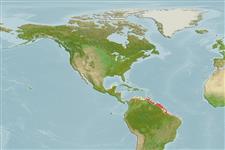Common names from other countries
>
Eupercaria/misc (Various families in series Eupercaria) >
Sciaenidae (Drums or croakers)
Etymology: Lonchurus: Greek, logche = lance + Greek, oura = tail (Ref. 45335).
Environment: milieu / climate zone / depth range / distribution range
Ecologia
marinhas; estuarina demersal; intervalo de profundidade ? - 25 m (Ref. 5217). Tropical
Western Atlantic: Colombia (Ref. 5217) to Brazil.
Tamanho / Peso / Idade
Maturity: Lm ? range ? - ? cm
Max length : 32.0 cm TL macho/indeterminado; (Ref. 9626); common length : 27.0 cm TL macho/indeterminado; (Ref. 3702)
Espinhos dorsais (total) : 11; Raios dorsais moles (total) : 32 - 34; Espinhos anais: 2; Raios anais moles: 7. Colour dark greyish above, yellowish to pale below. Pectoral fins long and jet black. Tips of pelvic and anal fins dark. Inside of gill cover black. Eye small, about 8 to 9 times in head length. Mouth small, inferior, enclosed under snout. Chin with 5 pores and many barbels, 3 to 4 pairs in a tuft around median mental pore, 15 or 16 pairs along median edges of lower jaws and subopercles. Pectoral fins greatly enlarged, extending beyond anal-fin base. Gas bladder narrow, about equal to head length, bearing anteriorly 2 pairs of appendages, anterior pair short and horn-like, lateral pair long, tube-like, extends to posterior end of gas bladder (Ref 51721).
Found over mud or mud-sand bottoms of estuaries and adjacent areas (Ref. 5217). Feeds on bottom-dwelling organisms, mainly worms. Marketed fresh and salted.
Life cycle and mating behavior
Maturities | Reprodução | Spawnings | Egg(s) | Fecundities | Larvas
Chao, L.N., 1978. Sciaenidae. In W. Fischer (ed.) FAO species identification sheets for fishery purposes. West Atlantic (Fishing Area 31). Volume 4. FAO, Rome. (Ref. 3702)
Categoria na Lista Vermelha da IUCN (Ref. 130435)
CITES (Ref. 128078)
Not Evaluated
Ameaça para o homem
Harmless
Utilização humana
Pescarias: pouco comercial
Ferramentas
Relatórios especiais
Descarregue XML
Fontes da internet
Estimates based on models
Preferred temperature (Ref.
115969): 27 - 28.3, mean 27.5 (based on 362 cells).
Phylogenetic diversity index (Ref.
82804): PD
50 = 0.7500 [Uniqueness, from 0.5 = low to 2.0 = high].
Bayesian length-weight: a=0.00851 (0.00413 - 0.01752), b=3.08 (2.91 - 3.25), in cm Total Length, based on LWR estimates for this (Sub)family-body shape (Ref.
93245).
Nível Trófico (Ref.
69278): 3.3 ±0.31 se; based on food items.
Resiliência (Ref.
120179): Elevada, tempo mínimo de duplicação da população menor que 15 meses (Preliminary K or Fecundity.).
Fishing Vulnerability (Ref.
59153): Low vulnerability (22 of 100).
